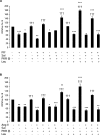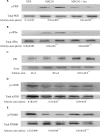Effect of branched-chain amino acids on muscle atrophy in cancer cachexia
- PMID: 17623010
- PMCID: PMC2267397
- DOI: 10.1042/BJ20070651
Effect of branched-chain amino acids on muscle atrophy in cancer cachexia
Abstract
In the present study, the BCAAs (branched-chain amino acids) leucine and valine caused a significant suppression in the loss of body weight in mice bearing a cachexia-inducing tumour (MAC16), producing a significant increase in skeletal muscle wet weight, through an increase in protein synthesis and a decrease in degradation. Leucine attenuated the increased phosphorylation of PKR (double-stranded-RNA-dependent protein kinase) and eIF2alpha (eukaryotic initiation factor 2alpha) in skeletal muscle of mice bearing the MAC16 tumour, due to an increased expression of PP1 (protein phosphatase 1). Weight loss in mice bearing the MAC16 tumour was associated with an increased amount of eIF4E bound to its binding protein 4E-BP1 (eIF4E-binding protein 1), and a progressive decrease in the active eIF4G-eIF4E complex due to hypophosphorylation of 4E-BP1. This may be due to a reduction in the phosphorylation of mTOR (mammalian target of rapamycin), which may also be responsible for the decreased phosphorylation of p70(S6k) (70 kDa ribosomal S6 kinase). There was also a 5-fold increase in the phosphorylation of eEF2 (eukaryotic elongation factor 2), which would also decrease protein synthesis through a decrease in translation elongation. Treatment with leucine increased phosphorylation of mTOR and p70(S6k), caused hyperphosphorylation of 4E-BP1, reduced the amount of 4E-BP1 associated with eIF4E and caused an increase in the eIF4G-eIF4E complex, together with a reduction in phosphorylation of eEF2. These changes would be expected to increase protein synthesis, whereas a reduction in the activation of PKR would be expected to attenuate the increased protein degradation.
Figures








Similar articles
-
Signaling pathways initiated by beta-hydroxy-beta-methylbutyrate to attenuate the depression of protein synthesis in skeletal muscle in response to cachectic stimuli.Am J Physiol Endocrinol Metab. 2007 Oct;293(4):E923-31. doi: 10.1152/ajpendo.00314.2007. Epub 2007 Jul 3. Am J Physiol Endocrinol Metab. 2007. PMID: 17609254
-
Acute oral leucine administration stimulates protein synthesis during chronic sepsis through enhanced association of eukaryotic initiation factor 4G with eukaryotic initiation factor 4E in rats.J Nutr. 2007 Sep;137(9):2074-9. doi: 10.1093/jn/137.9.2074. J Nutr. 2007. PMID: 17709445
-
Meal feeding enhances formation of eIF4F in skeletal muscle: role of increased eIF4E availability and eIF4G phosphorylation.Am J Physiol Endocrinol Metab. 2006 Apr;290(4):E631-42. doi: 10.1152/ajpendo.00460.2005. Epub 2005 Nov 1. Am J Physiol Endocrinol Metab. 2006. PMID: 16263769
-
Regulation of translation initiation by amino acids in eukaryotic cells.Prog Mol Subcell Biol. 2001;26:155-84. doi: 10.1007/978-3-642-56688-2_6. Prog Mol Subcell Biol. 2001. PMID: 11575165 Review.
-
Branched-chain amino acids activate key enzymes in protein synthesis after physical exercise.J Nutr. 2006 Jan;136(1 Suppl):269S-73S. doi: 10.1093/jn/136.1.269S. J Nutr. 2006. PMID: 16365096 Review.
Cited by
-
Leucine Supplementation Improves Effort Tolerance of Rats With Hyperthyroidism.Front Physiol. 2018 Nov 20;9:1632. doi: 10.3389/fphys.2018.01632. eCollection 2018. Front Physiol. 2018. PMID: 30524299 Free PMC article.
-
Polyphenol-Enriched Plum Extract Enhances Myotubule Formation and Anabolism while Attenuating Colon Cancer-induced Cellular Damage in C2C12 Cells.Nutrients. 2019 May 15;11(5):1077. doi: 10.3390/nu11051077. Nutrients. 2019. PMID: 31096595 Free PMC article.
-
Inhibition of SNAT2 by metabolic acidosis enhances proteolysis in skeletal muscle.J Am Soc Nephrol. 2008 Nov;19(11):2119-29. doi: 10.1681/ASN.2007101108. Epub 2008 Jul 23. J Am Soc Nephrol. 2008. PMID: 18650482 Free PMC article.
-
Supplementation of Magnolol Attenuates Skeletal Muscle Atrophy in Bladder Cancer-Bearing Mice Undergoing Chemotherapy via Suppression of FoxO3 Activation and Induction of IGF-1.PLoS One. 2015 Nov 24;10(11):e0143594. doi: 10.1371/journal.pone.0143594. eCollection 2015. PLoS One. 2015. PMID: 26600425 Free PMC article.
-
Branched-chain amino acids suppress insulin-resistance-based hepatocarcinogenesis in obese diabetic rats.J Gastroenterol. 2009;44(5):483-91. doi: 10.1007/s00535-009-0031-0. Epub 2009 Mar 25. J Gastroenterol. 2009. PMID: 19319465
References
-
- Khal J., Hine A. V., Fearon K. C. H., Dejong C. H. C., Tisdale M. J. Increased expression of proteasome subunits in skeletal muscle of cancer patients with weight loss. Int. J. Biochem. Cell. Biol. 2005;37:2196–2206. - PubMed
-
- Eley H. L., Tisdale M. J. Skeletal muscle atrophy: a link between depression of protein synthesis and increase in degradation. J. Biol. Chem. 2007;282:7087–7097. - PubMed
-
- Rowlands A. G., Panniers R., Henshaw E. The catalytic mechanism of guanine nucleotide exchange factor action and competitive inhibition by phosphorylated eukaryotic initiation factor 2. J. Biol. Chem. 1988;263:5526–5533. - PubMed
-
- Russell S. T., Eley H., Tisdale M. J. Mechanism of attenuation of angiotensin II-induced protein degradation by insulin-like growth factor I (IGF-I) Cell. Signalling. 2007;19:1797–1806. - PubMed
-
- Norton J. A., Gorschboth C. M., Wesley R. A. Fasting plasma amino acid levels in cancer patients. Cancer. 1985;56:1181–1186. - PubMed
Publication types
MeSH terms
Substances
LinkOut - more resources
Full Text Sources
Other Literature Sources
Research Materials
Miscellaneous

